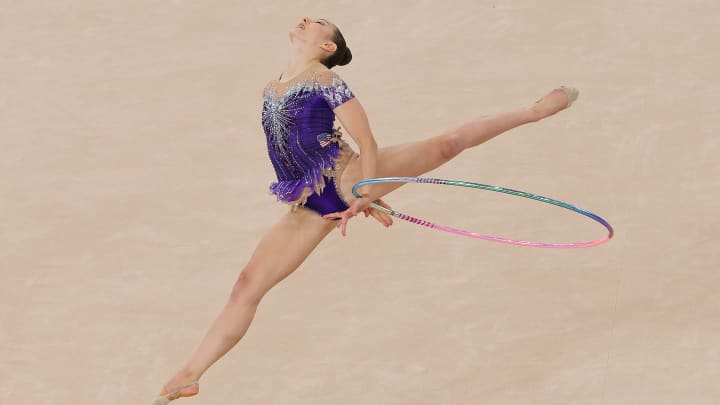The Ins, Outs, Ups and Downs of a Rhythmic Gymnastics Routine

The artistic gymnastics and trampoline segments at the Olympics finished earlier this week but there’s still one final gymnastics category going on in Paris: Rhythmic gymnastics. The U.S. did not qualify for the group competition, but will be represented by Evita Griskenas in the individual competition.
Unlike what viewers have seen in Bercy Arena throughout the first 10 days of the Games, rhythmic gymnastics won’t include the high-flying tumbling you’ve seen from Simone Biles or the effortless swinging from Stephen Nedoroscik (aka Pommel Horse Guy).
It is instead a “perfect blend of art and athleticism,” according to Griskenas.
The 23-year-old qualified for her second Olympics after winning a silver medal in the all-around at last November’s Pan American Games. Her road to Paris was not without its bumps. She spent several months in a walking boot with a foot fracture after securing her Olympic spot and did not return to the floor until February.
The Basics
For individuals, the rhythmic all-around competition consists of four apparatuses: the hoop, the ball, the clubs and the ribbon. Gymnasts are required to perform all four. (No specialists here.) Each routine lasts 90 seconds and all are performed to music. The music can be an instrumental or include lyrics.
The scores are made up of three parts: difficulty, execution and artistry, which are added up to get the total score for that apparatus.
What Makes Up a Routine
Body difficulty: balances, turns and leaps. Gymnasts must include at least one of each of these.
Dancing steps: sequences of movement to the music that last at least eight seconds. Gymnasts must include two.
Risks: high throws of the apparatus with two or more body rotations underneath (like somersaults or walkovers) and then a “crazy catch.”
Masteries: the smaller tricks that are combined together. Gymnasts can have a maximum of 20. The most common are snakes and spirals for ribbon, rolls for hoop and ball and flips for clubs.
All of these elements combine for an athlete’s difficulty score.
The execution score focuses on how clean and sharp a gymnast is and how well she completes the elements.
For the artistry score, judges are looking at if a gymnast hits the accent with the music, if she travels to all four corners of the carpet and her expression throughout the routine.
Both the execution and artistry scores are out of 10.000 each.
Creating the Routine
Rather than bring in an outside choreographer, Griskenas works with her coach to create her routines. She started with choreographing one routine (hoop) back in 2017—and she went on to win that year’s U.S. national hoop title.
“The music, I think, was called “Hana's Eyes.” It just really spoke to me,” Griskenas says. “And I went to my coach, and I was like, ‘I already envisioned the first half of this routine.’ And she was like, ‘Okay, show me.’ And so I did it. And then I was like, what if I did this and that? And long story short, I kind of created it without [meaning] to.”
For Griskenas, the first step is picking her music. She wants to connect emotionally with the music, and if applicable, the lyrics. In Paris, she will add some French flair to her ribbons routine set to “La Bohéme.” The 2022 U.S. national champion says that she focuses on telling a story with her body.
“One thing you want to do is listen to the accents. So you want to see what parts of the music tell you to do,” she says. “If you have a part of the music that goes zoop, to me, that’s like a throw. That seems very up. And then there’s parts where maybe it’s slower so you have lots of little teeny tiny baby steps as part of your dancing steps.”
As Griskenas choreographs, she takes the approach of, What does the apparatus tell me? The finishing position of one movement can often set up the next. She might catch the ball in one hold and because of how she’s holding it, her next move will be a throw since she’s already in the right position for it.
The rhythmic gymnastics individual all-around competition starts Thursday with the qualifying rounds. Griskenas, who finished 12th in Tokyo, wants first-time viewers to look for the expressivity of the music.
“The real magic happens where that seamlessness occurs, that transition,” she says. “And also when there's an accent, the music goes zoop and someone turns or you hear like, brrroom when someone goes right with their arm, like those are the moments that really make the sport so elevated and interesting.”
